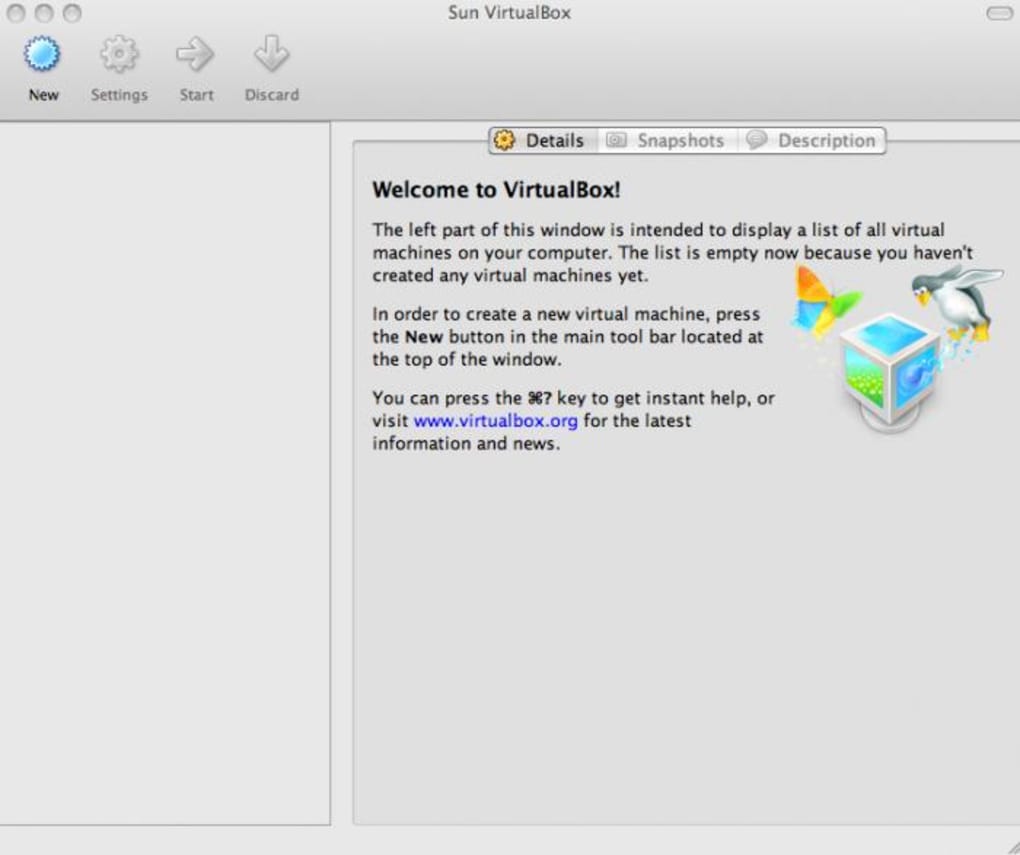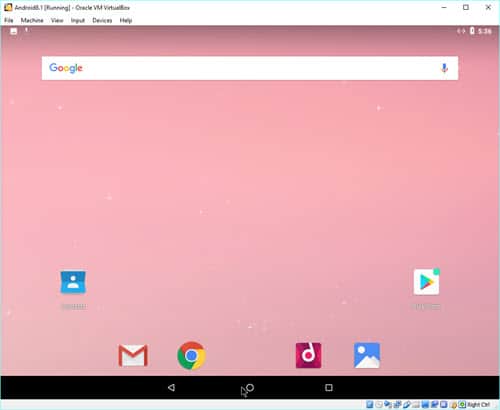Portable-VirtualBox is a free and open source software tool that lets you run any operating system from a usb stick without separate installation.
Use VirtualBox to run Android apps on Mac KO Player KO Player is an emulator software that allows Android apps run on Mac. This is basically an application to play Android games on your Mac. Android gamers and content creators can benefit largely from this software. Tested on VirtualBox 64-bit for Windows, version 5.2.0. Android-x86 version 6.0-r3, both 32-bit and 64-bit. Select your machine, then click the Settings button and refer to the below recommended configuration to make sure your settings match.

Installation instructions
- Download and run Portable-VirtualBox_v5.1.22-Starter_v6.4.10-Win_all.exe.
- Choose a folder to extract to.
- Go to the folder and run Portable-VirtualBox.exe. You'll see a window like the one below:
- If you have already downloaded the installer for VirtualBox from www.virtualbox.org click search and navigate to the file. If not, click 'Download The Installation Files of VirtualBox.' Portable-VirtualBox will show you the download's progress.
- Once the installer is download, check the boxes that are appropriate and click OK. Portable-VirtualBox will extract the files it needs from the VirtualBox installer, and restart itself afterward if you select the last checkbox.
Optional configuration
Portable-VirtualBox makes default settings automatically. You can modify them by pressing CTRL-5 or opening the tray menu while Portable-VirtualBox is running. Either action will bring up the configuration GUI below. The Hokey-Settings tab is shown open in the image below:
Features
- Splash screen to start and end
- Configurable Home Directory
- Launch the VirtualBox GUI or directly launch a VM
- Configure the hotkeys for managing your virtual machine
- Configure USB and network support
- Choose language for GUI
- Saves settings in editable *.ini-files
- Can automatically check for VirtualBox updates
- All absolute paths in the VirtualBox.xml are replaced automatically by relative paths
- Checks to make sure VirtualBox files exist
Install files signature
All install files after launcher version 6.4.10 is digitally signed. Signer is “Open Source Developer, Runar Buvik”, certificate is issued by Certum Level III CA. This is temporarily disabled until a new certificate arrives in the mail.
Note
VirtualBox needs several kernel drivers installed and needs to start several services: if the drivers and services are not already installed you'll need administrator rights to run Portable-VirtualBox.
When Portable-VirtualBox starts, it checks to see if the drivers are installed. If they are not it will install them before running VirtualBox and will remove them afterward. Similarly, Portable-VirtualBox checks to see if the services are running. If not, it will start them and then stop them when it exits.
If you want to save space you can remove the language files for other languages than your own. That can save you nearly 10 MB. They are in the nls directory.
You can also delete the documentation saving nearly 5 MB. You will find it in the doc directory.
When the VM is running you must press the 'Host-Key' (initially configured as the right CTRL-Key) to be able to use the other Hotkeys since otherwise the VM will have the focus.
Network support
- To download of Portable-VirtualBox
- Unpack from Portable-VirtualBox
- Start from Portable-VirtualBox
- Attitudes open (Tray --> attitudes, CTRL+5) --> rider Network (Tab) --> VirtualBox with network support start --> memory (save)
- Terminate from Portable-VirtualBox
- Start from Portable-VirtualBox
- Driver installation agree
- Wait
- Selection of a VM and the network map to host interfaces stop
- Attitudes make
- FINISHED
Virtualbox Android Apk
Languages of Launcher
English, German, Portuguese, Spanish, French, Italian, Chinese, Japanese, Polish, Russian and Ukrainian.
Important
None of the files that come from VirtualBox are modified or otherwise changed.
Portable-VirtualBox downloads the VirtualBox installer which contains all of the VirtualBox files and drivers. Portable-VirtualBox unpacks the files and stores them in subdirectories . Portable-Virtualbox can also compress them in order to save space.
[adsense:client=ca-pub-123456,slot=123456,type_ad=head]
Mac sales have been growing ever since Apple moved from PowerPC to Intel processors, in no small part because that made it possible to run Windows on Macs at full speed. No more Intel emulation. No more DOS cards. Boot Camp and then virtualization apps made it easy to run other operating systems on Intel-based Macs.
The best low-end virtualization solution is VirtualBox, a free virtualizer for modern Macs. I don’t do Windows, but VirtualBox lets you work in Linux, FreeBSD, FreeDOS, other versions of macOS, and perhaps even MorphOS and other less-well-known operating systems.
I mostly use it for Andy, an Android emulator from Andyroid.net. Sometimes a 4″ iPhone screen is just too small, and many mobile games are available for both iOS and Android.
One drawback is that there are an awful lot of settings in VirtualBox but little in the way of advice on which ones work best. How much memory should I allocate? How about video memory? Should I let it use 100% of my processing power? Do any of the acceleration settings work? What settings will prevent it from working?
I’ve been learning as I go, and these are some of my discoveries. Most of this has been done on my 3.06 GHz i3-based 21.5″ Mid 2010 iMac with 12 GB RAM running Mac OS X 10.11.6 El Capitan, but I have also run VirtualBox and Andy on my 2.0 GHz Core Duo 13.3″ Late 2008 Aluminum MacBook with 12 GB RAM and El Capitan. The MacBook is quite a bit slower with Andy than the i3-based iMac.
Installing Andy

First of all, if you’ve installed Andy, VirtualBox, or Advanced Mac Cleaner in the past, put them in the Trash before running the installer for the current version. Sometimes the installer balks at previous versions.
When you install Andy on a Mac, it installs VirtualBox for you. It also offers to install Advanced Mac Cleaner and make Yahoo! your default search engine. I am leery of free utility apps that want to put themselves in your startup queue and come from unknown sources. And Yahoo! is about the worst search engine ever, so I skipped installing either of these.
Andy installs its own copy of VirtualBox (version 5.0.18 r106667), and I’ve learned the hard way that you don’t want to update it to the latest version. Andy will not be happy if you do. Once everything is installed, double-click on Andy just to make sure it runs.
VirtualBox Settings
Once you know it runs, install whatever game or app you want to use with the Android emulator using the Google Play store and make sure that it runs acceptably. We’re going to tweak some settings to hopefully make Andy run a bit more smoothly, but if it’s unacceptably slow to begin with, don’t expect these adjustments to mean much.
Once you finish making your setting, quit VirtualBox, and then launch Andy, which will take care of restarting VirtualBox with your new settings.
Settings: General
Quit Andy – you can’t change most of the VirtualBox settings while virtualization is active – and then double-click the VirtualBox icon. Next click on the yellow Settings gear. The first option in Settings is General, with four tabs: Basic, Advanced, Description, and Encryption. Under Basic, leave the Type as Linux, and then the Version to Linux 2.6, etc. (32-bit or 64-bit).
I don’t change anything in the Advanced tab, but if you want a shared clipboard or Drag’N’Drop support, this is where you would activate it. Description lets you make notes for yourself, and Encryption is probably best avoided, at least for now.
Settings: System
The System section has three tabs: Motherboard, Processor, and Acceleration. Unless RAM is really at a premium in your Mac, I suggest you boost it from the stock 1280 MB to 2048 MB or beyond. It can’t hurt and may improve performance. Some suggest setting it at 4096 MB* if you have enough system memory. In the Boot Order section, you can turn off Optical unless you might be booting Linux or something else from a CD or DVD.
* Andy is a 32-bit app and can only use up to 3,072 MB of RAM.
Windows Virtual Machine For Mac
I have fiddled with the Chipset and Pointing Device settings, but nowadays I just leave them at default. I do the same with the Extended Features.
The Processor tab lets you determine how many cores VirtualBox assigns to your virtualized operating system. My Intel Macs are all dual-core, so I let VirtualBox use both of them. You can also set an Execution Cap, which will prevent the virtualized OS from totally taking over your Mac. I usually set that at 90% on my older, slower MacBook and 95% on the iMac. That allows background tasks enough elbow room to run without cutting into your Android emulation significantly. “Enable PAE/NX” under Extended Features seems to be a Windows thing; you can ignore it unless you’re virtualizing Windows.
The third tab is Acceleration, and that’s the first one to really frustrate me. You have five acceleration options plus None. Based on your OS and hardware, VirtualBox should pick the best option for your system. Hardware Virtualization is only available on Intel Core i7 CPUs; if your Mac has an i7, click Enable Nested Paging for significantly faster paging.
Settings: Display
On my iMac, the default setting in Video Memory is 12 MB. Since I have 12 GB of RAM in this iMac, I boost this to 20-24 MB. It can’t hurt.
I don’t worry about multiple monitors or Scale Factor. For Andy, you probably don’t need to either. If your Mac has a Retina Display, enable HiDPI Support.

I have tried to Enable 3D Acceleration, but when I do, Andy never completes the boot process. If I try to Enable 2D Video Acceleration, VirtualBox warns me that this is an invalid setting.
There are tabs for Remote Display and Video Capture, neither of which I have had a reason to try.
Settings: The Rest

I just leave these as is.
How Well Does It Work?
Andy runs an x86 version of Android, and it seems to run apps correctly. It’s not particularly fast on my 2.0 GHz Core 2 Duo MacBook, but an adequate performer on the 3.06 i3-based iMac.
One huge plus is that you get to use your Mac’s keyboard for text input. I learned to touch-type in high school, so this is much faster than the on-screen keyboard. Also, the mouse cursor gives you more precise control than your finger on an Android phone or tablet.
But there are drawbacks, things that you can’t do like zooming in and out, multi-finger gestures, and other things that are so easy with a touch interface. I don’t find Clash of Clans practical on my iMac, although it does look much nicer on Andy than on my 4″ iPhone SE.
Update: You can zoom in and out by holding down the Option key and holding down the mouse button (left button on a non-Apple mouse).
Is It Worth It?
Until I figured out how to use BlueStacks, which is billed as an app player and not a full-fledged Android environment, I found Andy had some benefits over my iPhone or my 7″ Android Fire, mostly in the resolution department. It works, but it is slow and has some touch-based limitations not present in a real Android device.
keywords: #andyroid #androidemulation
short link: https://goo.gl/RLWfVg